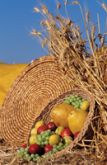×


We have detected your country as:
Please click here to go to the USA website or select another country from the dropdown list.
 Other customs have grown up around Shavuot, such as parades at agricultural kibbutzim (communal settlements) where ornately decorated floats display the harvest in joyful processions.
Other customs have grown up around Shavuot, such as parades at agricultural kibbutzim (communal settlements) where ornately decorated floats display the harvest in joyful processions.
Traditionally in the synagogue, the book of Ruth is read because of its agricultural focus, because Ruth’s conversion represents a voluntary acceptance of the Torah and God’s covenant, and
because tradition says that King David, of Ruth’s lineage, was born and died on Shavuot.
Perhaps the most beautiful of all, however, is the Sephardic tradition of the Shavuot marriage between God as the groom and Israel as His bride. With Mount Sinai as the chuppah (canopy),
a ketubah (marriage agreement) is written each year. The following is an excerpt from one such text: “The Bridegroom [God], Ruler of rulers, Prince of princes, Distinguished among the select, whose mouth is pleasing and all of Whom is delightful, said unto the pious, lovely and virtuous maiden [the people of Israel] who won His favor above all women, who is beautiful as the moon, radiant as the sun, awesome as bannered hosts: ‘Many days wilt thou be mine and I will be thy Redeemer.’”
By Cheryl Hauer, International Development Director
Photo Credit: www.israelimages.com
Photo Credit: www.bibleplaces.com/Todd Bolen
Photo Credit:
All logos and trademarks in this site are property of their respective owner. All other materials are property of Bridges for Peace. Copyright © 2024.
Website Site Design by J-Town Internet Services Ltd. - Based in Jerusalem and Serving the World.